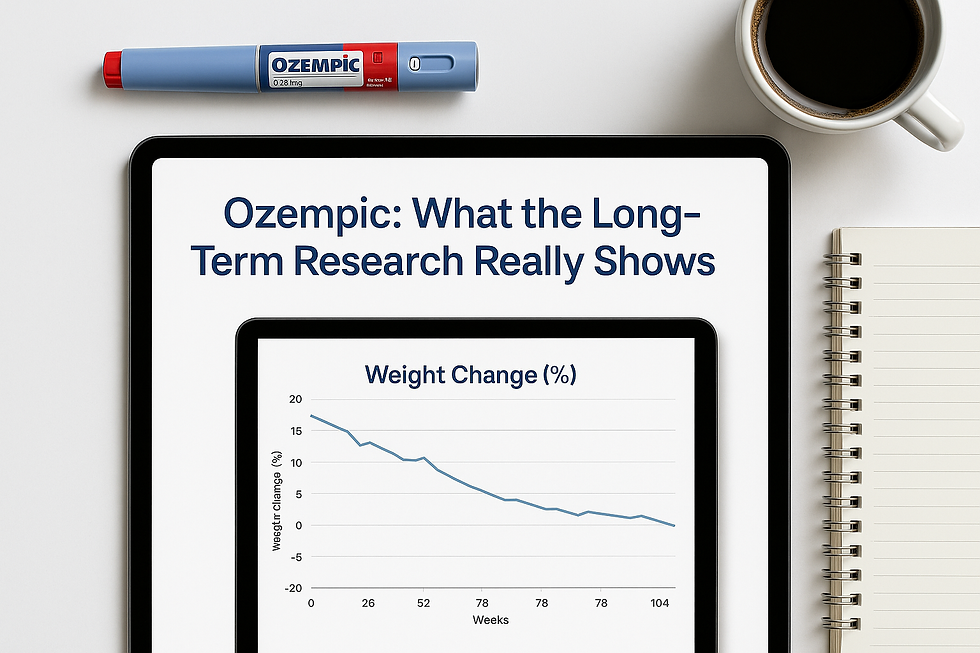Case Study: Ozempic & the Habits Gap in Sustainable Transformation
- Barry McGinley
- Nov 5
- 3 min read
Why the “magic injection” isn’t a shortcut for lasting change
Introduction
Ozempic has become headline news in the health & fitness world. Originally developed for type-2 diabetes, it’s now widely used (sometimes off-label) for weight loss and body composition changes. While the early data looks impressive, there are important caveats, especially for those of us in the performance, strength & conditioning space. As a coach who helps busy professionals build real habits, I believe understanding both sides of this story matters.

What the Research Shows (the upside)
Weight and fat reduction
A study of semaglutide in people with obesity (without diabetes) found a sustained mean weight reduction of ~10.2% over 208 weeks (≈4 years) compared to ~1.5% in placebo. Cleveland Clinic+3PubMed+3Nature+3
Another trial showed that in patients using semaglutide for obesity, ~37% achieved ≥10% body weight reduction at 12 months. Cleveland Clinic+1
For metabolic health, semaglutide has shown benefits beyond weight – such as reduction in waist circumference, improvements in anthropometric measures. Nature
Additional potential health benefits
Some sources suggest semaglutide (and similar GLP-1 agonists) may reduce risks of diabetes-related complications (kidney disease, retinopathy) in people with diabetes. lindushealth.com+1
Emerging research is looking at GLP-1 drugs for broader metabolic and cardiovascular effects. medicine.iu.edu
Thus, the “upside” is clear: for the right person, under medical supervision, Ozempic can be a powerful tool in the toolbox.
What the Research Shows (the considerations & risks)
Side-effects and safety
Common side effects include gastrointestinal issues: nausea, vomiting, diarrhea, constipation. public-health.uq.edu.au+1
Serious potential long-term risks include gallbladder disease, pancreatitis, diabetic retinopathy, and a boxed warning for thyroid C-cell tumours in rodents (unknown in humans). Healthline+1
“Ozempic face” has become a term: rapid fat loss around the face and jawline which can lead to aesthetic/structural changes. Harvard Health
Sustainability & dependency
A real-world U.S. analysis found that only ~22% of Ozempic users (for weight-loss use) remained on the medication at 2 years. Reuters
Some trial data suggest that when semaglutide is discontinued, much of the weight loss is regained over time. Wikipedia+1
Habits, behaviour & cost
While Ozempic handles physiological suppression of appetite and reduces fat mass, it doesn’t automatically create strong lifestyle habits (training, nutrition, movement, recovery). Without those, the actual “transformation” may be fragile.
Cost is another major barrier: some GLP-1 therapies cost hundreds to thousands of dollars/month in certain markets. Long-term use may raise affordability and equity issues.
Why This Matters for Busy Professionals & Performance-Driven Individuals

As a coach working with high-performers (executives, ex-athletes, professionals over 30), the appeal of a “quick fix” is understandable less time, heavy pressure, desire for results. But:
Habit formation (consistent resistance training, aerobic conditioning, mobility, recovery, nutrition structure) is what drives sustainable change in energy, confidence, leadership, movement quality and athleticism.
Relying on a pharmacological aid like Ozempic without building the behavioural ecosystem means when the drug stops (or is paused), you risk regression.
The transformative performance you seek isn’t just a body weight number — it’s how you move, feel, think, recover, and lead. That requires systems, not just injections.
My Coaching Perspective & Practical Takeaways
Use it if medically appropriate - If you’re prescribed Ozempic (or similar) by a qualified clinician, it may be a valid adjunct in your toolkit.
Parallel the habit-building - Don’t wait for “when I’m leaner” to train with purpose. Start or maintain your performance system now.
Focus on retention, not just loss - Keep the behaviours, not just the drug. Build your daily training routine, recovery structure, movement baseline.
Budget for long-term costs - If you’re using a pharmacological route, plan financially and mentally for ongoing use (or transitions).
See the drug as a tool, not the mission - Your mission is to be leaner, stronger, injury-free, high energy, moving well into your 40s/50s. Your system (training, recovery, habit) is the foundation.
If you’re using, considering, or simply curious about Ozempic or any weight-loss medication:
Educate yourself - talk to medical professionals, understand the benefits vs risks.
Pair it with a system - If you aren’t already training with a performance coach and lifestyle system, you’ll miss out on the real payoff.
Think long-term - The investment in habit, energy, recovery will out-last any drug.
Book your system audit - If you want to commit to a system that builds your energy, strength and movement quality while you figure out your path (with or without medication), reach out.




Comments